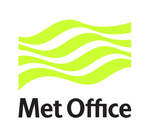
| Met Office Hadley Centre observations datasets |
| > Home > HadSST3 > Diagnostics > |

Map of monthly average Sea surface temperature (SST) anomalies (relative to 1961-1990) from HadSST3. White areas represent gridboxes containing no SST data. Although the data have been quality controlled, the uncertainties in some grid boxes are larger than in others. Large uncertainties arise when the grid box average is based on only a small number of observations, or on measurements from a small number of ships or drifters. Where uncertainties are largest (see below) the variability of the observed SST anomalies will be higher with unexpectedly high or low values. When assessing the reliability of the SST anomaly fields it is helpful to refer to the estimated uncertainties shown below. Data can be found on the download page

Map of 2-sigma sea surface temperature (SST) anomaly uncertainties. Uncertainties are larger when there are fewer observations contributing to the grid box average, when the average is based on data from a small number of ships or drifting buoys and when metadata concerning measurement method is absent. Uncertainties are also larger where the SST field is inherently more variable. Uncertainties are smallest on well travelled shipping lanes and in areas with large numbers of drifting buoys. Uncertainties are largest in sparsely sampled regions due to a combination of lack of shipping and drifting buoy coverage. The maps were created by combining the ensemble spread from the 100 realisations of the data set with measurement and sampling uncertainties. Data can be found on the download page

Map of monthly average Sea surface temperature (SST) anomalies (relative to 1961-1990) from HadSST3. White areas represent gridboxes containing no SST data or where the estimated 2-sigma uncertainty exceeds 0.8K. Using a cutoff of 0.8K will remove grid box averages that are based on a small number of observations from a single ship. This will minimise the occurrence of 'bulls-eyes' in the observed anomaly fields.
Commercial and media enquiriesYou can access the Met Office Customer Centre, any time of the day or night by phone, fax or e-mail. Trained staff will help you find the information or products that are right for you. |
 |
Maintained by: John Kennedy |
© Crown Copyright
|